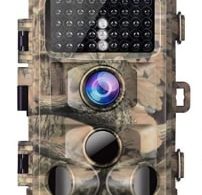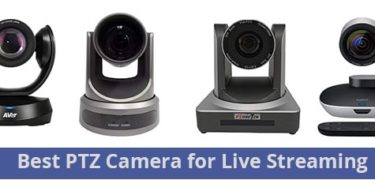As an Amazon Associate, I can earn from qualifying purchases. Learn more.
A security camera system with DVR (or NVR) is usually the best option to monitor a large property. Besides a single control hub for many cameras, there’s the advantage of free local storage. But we recommend calculating how much storage you need for your DVR to make sure the hard disk will be enough for all your recordings.
Of course, not many people bother doing this calculation. But the fact is that knowing how much storage security cameras use is very crucial when you want to make the most of them.
For instance, when you know the amount of storage you need for your DVR, it’s easy to determine how far back you can playback footage. And this in turn helps make sure you’ve installed a hard disk that suits your recording needs.
When you’re planning to get a CCTV system, an overview of how much storage you need for your DVR also helps in determining the initial costs. It’s the reason we’re against using another person’s installation quotation, as your needs and preferences may vary.
Security Camera Storage Calculator
Crucial Tips when Calculating How Much Storage You Need for Your DVR
As we’ve just mentioned, the amount of storage needed for a DVR varies since we all have different needs and preferences. The seven factors that determine the various storage requirements include:
- The number of security cameras connected to your DVR is the first factor that affects your storage requirements. If you have many cameras around your property, you’ll need more storage space than someone with fewer devices.
- The video resolution you want your security cameras to record is the second factor that affects your DVR storage needs. If you have 4K security cameras and want them to record in Ultra-HD (3840×2160p) quality, your DVR uses more storage than lower resolutions.
- The video frame rate you want your security cameras to record also impacts storage consumption. When you set your cameras to record at a high frame rate, they capture more details of the area. And a footage file with more details automatically uses more storage space.
- The video codec/ encoding/ compression mode is the other factor that affects how much storage your security cameras use. If you’ve selected the HEVC (High-Efficiency Video Coding) or H.265 mode, the storage consumption can be over 50% less than the standard H.264 codec.
- Will your security cameras record video with or without audio? Audio is another detail that increases the file size of your security camera recordings. A larger footage file means you’ll need more storage space for your DVR.
- The number of days you’d want your security cameras to record will also determine your storage consumption. If you want a video history of 30 days or more, you’ll definitely need a large hard disk capacity.
- The video recording mode you’d want your security cameras to record on is another factor that determines the storage consumption. In the continuous video recording mode, you’ll get to use more storage space than in the motion-activated or scheduled recording option.

Calculating How Much Storage You Need for Your DVR
How much storage do security cameras use? Unfortunately, there’s no standard formula to calculate the amount of storage you need for your DVR.
YES, yes there are now online CCTV calculators you can use to do the calculations. But the calculators only give an estimate, which should explain why different companies show different results.
Perfect examples are the Seagate Surveillance Storage Calculator, CCTV Camera Pros Video Storage Calculator, AI Security Cameras Storage Calculator, and CCTV Calculator. When we tested these calculators (and several others), there was a variation of 3 – 6% between them. Some of the companies do mention the tool “was primarily developed” for their systems, though.
As video surveillance technology continues to improve, so do these storage consumption calculators. If you check out the latest calculators like CCTV Cameras Pro or AI Security Cameras, they have the choice of 12MP (4000 x 3000p) resolution.
Also, you can calculate the storage consumption of 4K security cameras at a frame rate of up to 60fps. But on the plus side, these CCTV systems with high resolution and frame rate also have the latest encoding/ compression mode.
HEVC or H.265 is the latest/ highest video encoding/ compression/ codec standard at the moment. It’s more efficient than H.264, as your cameras will use less storage space while retaining the same video quality.
Nevertheless, you should know there are different versions of H.265 video compression (currently at version 7). And this is why you’ll see CCTV brands, such as GW Security camera, claim to support H.265+. (Some companies still list their products as H.265 even when using the latest encoding version).
How Much Storage Do Security Cameras Use in 4K, 2K, or 1080p Resolution?
Below is a quick summary of how much storage security cameras use to record in 4K, 2K, and 1080p HD. The storage consumption calculation is for six security cameras while using the CCTV Camera Pros Video Storage calculator. (We’ve also based the summary on a 30-day history, with continuous [24/7] video recording mode).
| Security Camera | Native Resolution | Video Frame Rate | Video Encoding | Storage Used (in 30 days) |
| 4K UHD | (3840 x 2160p) | 60fps | H.265 | 15.39TB |
| 4K UHD | (3840 x 2160p) | 60fps | H.264 | 30.78TB |
| 4K UHD | (3840 x 2160p) | 30fps | H.265 | 12.31TB |
| 4K UHD | (3840 x 2160p) | 30fps | H.264 | 24.62TB |
| 4K UHD | (3840 x 2160p) | 25fps | H.265 | 10.26TB |
| 4K UHD | (3840 x 2160p) | 25fps | H.264 | 20.52TB |
| 2K QHD | (2688 x 1520) | 60fps | H.265 | 6.79TB |
| 2K QHD | (2688 x 1520) | 60fps | H.264 | 13.58 TB |
| 2K QHD | (2688 x 1520) | 30fps | H.265 | 5.43 TB |
| 2K QHD | (2688 x 1520) | 30fps | H.264 | 10.86 TB |
| 1080p FHD | (1920 x 1080p) | 60fps | H.265 | 4.98 TB |
| 1080p FHD | (1920 x 1080p) | 60fps | H.264 | 9.96 TB |
| 1080p FHD | (1920 x 1080p) | 30fps | H.265 | 3.98 TB |
| 1080p FHD | (1920 x 1080p) | 30fps | H.264 | 7.97 TB |
Make Sure You Always Have Enough Storage
Whatever the reason may be, that’s the way to calculate how much storage you need for your DVR or NVR.
Well, technically, the online surveillance storage calculator software does the calculating for you. All you’ll just need to do is enter the necessary parameters (number of cameras, resolution, frame rate, encoding, etc.) in the software tool. Then it (the security camera storage calculator) will display the storage consumption- both in the motion recording and continuous recording mode.
Keep in mind, these calculators only give an estimate of the storage consumption for your security cameras- not the exact figures. If the idea was to use this information to purchase a hard drive, we, therefore, recommend a slightly more storage capacity than the results shown.
Speaking of more storage, some DVRs usually have multiple hard drive bays and the option to add external local storage. Lorex security camera system is a good example, whereby you can add up to 20TB of local storage.
If, by chance, you max out your DVR storage, you’ll need to adjust the related settings to make sure you always have enough space. “Related settings” are the factors we mentioned earlier, such as image resolution, frame rate, encoding, et cetera.



